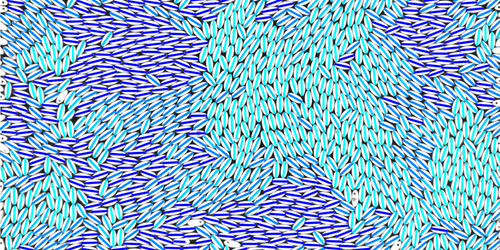Defects Help 3D-Printed Particles Keep on Swirling
If you supercool a liquid, the temperature drop causes the liquid’s particles to become more and more sluggish until their motion becomes so slow that the liquid effectively behaves like a glass. So-called glassy dynamics—behaviors associated with glasses—appear in traditional liquids, such as water or melted sand, and in nontraditional ones, such as dense collections of self-propelled particles known as active matter. Pragya Arora and her colleagues at the Jawaharlal Nehru Center for Advanced Scientific Research in India studied the dynamics of one type of artificial active-matter particle, finding that patterns can form in the system that help it elude turning glassy [1]. The results could help researchers better understand the behaviors of living active particles, such as the cells in our bodies.
For their active-matter particle, Arora and her colleagues used 2×6-mm 3D-printed plastic ellipsoids. They “activated” the particles by vertically shaking the surface on which the particles lived. Like little autonomous critters, the particles used the energy from the vibrations to scurry around the surface. The team was able to tune how much a particle scuttled about by changing its center of mass, which they did by adding a hole along the particle’s body.
At higher particle densities, Arora and her colleagues found that the most active particles spontaneously coalesced into bunches and swirls. They watched domains of particles form with different alignments. At the boundaries of these domains were “defects,” where the particles switched from one alignment to another.
The team found that the presence of these defects allowed the particles to move around, even when the system was deep in the glassy regime where a group of nonactive particles would behave like a solid. Arora says these defects are known to play a role in the human body’s defense against precancerous, abnormal cells, so studying their dynamics in greater detail could add to our understanding of this process.
Correction (28 April 2022): The caption of the first video was updated to correctly describe how the researchers tuned the activity level of the particles.
–Katie McCormick
Katie McCormick is a freelance science writer based in Sacramento, California.
References
- P. Arora et al., “Motile topological defects hinder dynamical arrest in dense liquids of active ellipsoids,” Phys. Rev. Lett. 128, 178002 (2022).




